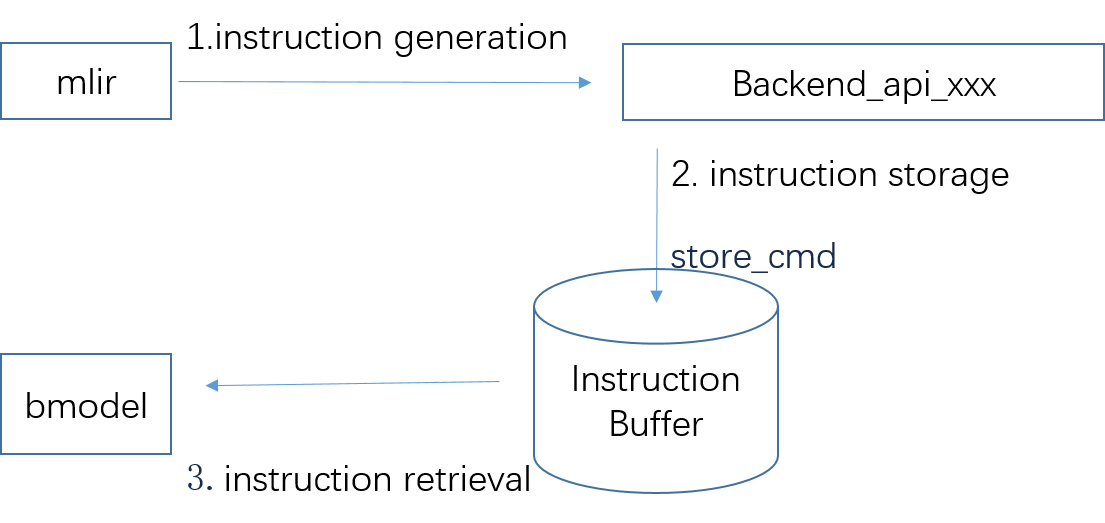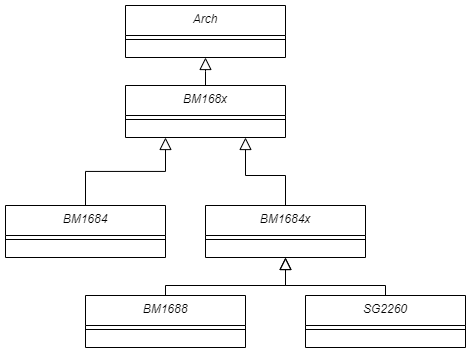12. CodeGen
The code generation (CodeGen) in TPU-MLIR is the final step of BModel creation. Its purpose is to convert MLIR files into the final BModel. This chapter introduces the CodeGen of models/operators in this project.
12.1. Main Work
The purpose of CodeGen is to convert the MLIR file into the BModel file. This process will execute the CodeGen interface of each op to generate cmdbuf, and use the Builder module to generate the final BModel in flatbuffers format.
12.2. Workflow
The general process of CodeGen can be divided into three parts: instruction generation, instruction storage and instruction retrieval.
Instruction generation: Encapsulate the back-end functions of different processors into classes, execute the op’s CodeGen interface, and generate corresponding instructions (binary code);
Instruction storage: Store the instruction (binary code) in the specified data structure through store_cmd;
Instruction retrieval: After the binary codes of all ops are generated, the compiler will call the function encapsulated in the BM168X series class to retrieve the instructions, and finally generate the Bmodel.
The workflow is as follows:

Fig. 12.1 CodeGen Workflow
The following introduces the data structures required in the CodeGen process:
The instructions differ based on the processor’s engine, e.g., 1684 has GDMA and TIU, while new architecture processors like bm1690 have sdma, cdma, etc. Using the most common engines, BDC (later renamed to TIU) and GDMA, as examples:
std::vector<uint32_t> bdc_buffer;
std::vector<uint32_t> gdma_buffer;
uint32_t gdma_total_id = 0;
uint32_t bdc_total_id = 0;
std::vector<uint32_t> gdma_group_id;
std::vector<uint32_t> bdc_group_id;
std::vector<uint32_t> gdma_bytes;
std::vector<uint32_t> bdc_bytes;
int cmdid_groupnum = 0;
CMD_ID_NODE *cmdid_node;
CMD_ID_NODE *bdc_node;
CMD_ID_NODE *gdma_node;
bdc_buffer: stores bdc instructions
gdma_buffer: stores gdma instructions
gdma_total_id: The total number of gdma instructions stored
bdc_total_id: The total number of bdc instructions stored
gdma_bytes: number of gdma instruction bytes
bdc_bytes: bdc instruction byte number
12.4. Backend Function Loading
The backend is placed as a dynamic library in the TPU-MLIR project, specifically at third_party/nntoolchain/lib/libbackend_xxx.so. The loading method of the backend function is: first define the function pointer, and then load the dynamic library so that the function pointer points to the function in the dynamic library.
- Take the synchronization function tpu_sync_all as an example, as we will add multi-core support later, it needs to be well-defined in the relevant backend cmodel library.
Make sure to keep the function name and parameters consistent: `typedef void (*tpu_sync_all)();
Add this function member within the class: `tpu_sync_all, dl_tpu_sync_all;
Add the macro, CAST_FUNCTION(tpu_sync_all), to the implementation of this type of load_functions function; This macro can point dl_tpu_sync_all to the function in the dynamic library.
After obtaining an instance of this class, we can use the functions in the dynamic library.
12.5. Backend store_cmd
The function store_cmd in the backend refers to the process where the compiler calls the operators and saves the configured instructions to the designated space. The key function in the backend is in store_cmd.cpp; for example, cmodel/src/store_cmd.cpp; cmodel/include/store_cmd.h. store_cmd has a series of EngineStorer and CmdStorer classes:
1. EngineStoreInterface (interface class), GDMAEngineStorer, BDEngineStorer and other specific classes that inherit from the EngineStoreInterface interface, EngineStorerDecorator (decoration class interface), VectorDumpEngineStorerDecorator and other specific decoration classes that inherit from EngineStorerDecorator 2. CmdStorerInterface (interface), ConcretCmdStorer inherited from the interface, StorerDecorator: decoration interface, VectorDumpStorerDecorator specific decoration class.
- Relationship and Logic Among the Classes:
Using the singleton design pattern, there is only one ‘ConcretCmdStorer’ class in ‘store_cmd’, which will store all ‘EngineStorer’ classes. When different engines are called, different ‘EengineStorers’ will be called, as shown in the code below.
virtual void store_cmd(int engine_id, void *cmd, CMD_ID_NODE *cur_id_node, int port) override { switch (engine_id) { case ENGINE_BD: case ENGINE_GDMA: case ENGINE_HAU: case ENGINE_SDMA: port = 0; break; case ENGINE_CDMA: ASSERT(port < CDMA_NUM); break; case ENGINE_VSDMA: engine_id = ENGINE_SDMA; break; default: ASSERT(0); break; } return this->get(engine_id, port)->store(cmd, cur_id_node); }
The function of ‘EngineStorer’ is to parse commands. ‘VectorDumpEngineStorerDecorator’ executes the ‘store’ function and ‘take_cmds’ function in the ‘EngineStorer’ class to store all instructions in output_.
class VectorDumpEngineStorerDecorator : public EngineStorerDecorator { private: std::vector<uint32_t> *&output_; void take_cmds() { auto cmds = EngineStorerDecorator::get_cmds(); (*output_).insert((*output_).end(), cmds.begin(), cmds.end()); } public: VectorDumpEngineStorerDecorator(ComponentPtr component, std::vector<uint32_t> **output) : EngineStorerDecorator(component), output_(*output) {} virtual void store(void *cmd, CMD_ID_NODE *cur_id_node) override { EngineStorerDecorator::store(cmd, cur_id_node); if (!enabled_) return; this->take_cmds(); } virtual void store_cmd_end(unsigned dep) override { EngineStorerDecorator::store_cmd_end(dep); this->take_cmds(); } };
